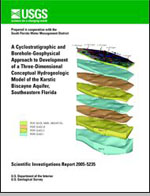A cyclostratigraphic and borehole-geophysical approach to development of a three-dimensional conceptual hydrogeologic model of the karstic Biscayne aquifer, southeastern Florida
Links
- More Information:
- Download citation as: RIS | Dublin Core
Abstract
A fundamental problem in the simulation of karst ground-water flow and solute transport is how best to represent aquifer heterogeneity as defined by the spatial distribution of porosity, permeability, and storage. Combined analyses of cyclostratigraphy, including lithofacies and depositional environments, and borehole-geophysical logs, has improved the conceptualization of porosity, permeability, and storage within the triple-porosity karstic Biscayne aquifer in an approximately 95-square-mile study area of Miami-Dade County in southeastern Florida. The triple porosity of the Biscayne aquifer is principally: (1) matrix of interparticle and separate-vug porosity, providing much of the storage, and under dynamic conditions, diffuse-carbonate flow; (2) touching-vug porosity creating stratiform ground-water flow passageways; and (3) less common conduit porosity composed mainly of bedding-plane vugs, thin solution pipes, and cavernous vugs. These three conduit porosity types are all pathways for conduit ground-water flow.
To develop an accurate three-dimensional conceptual hydrogeologic model of the Biscayne aquifer in the study area, a detailed analysis of data was conducted that include continuously drilled cores, digital borehole images, borehole-fluid conductivity and temperature logs, and borehole-flowmeter measurements from 25 wells that fully penetrate the Biscayne aquifer. Six depositional environments for major lithologic components of the Biscayne aquifer--the Tamiami Formation, Fort Thompson Formation, and Miami Limestone--include: (1) middle ramp, (2) platform margin-to-outer platform, (3) open-marine platform interior, (4) restricted platform interior, (5) brackish platform interior, and (6) freshwater terrestrial environments. High-frequency cycles form the fundamental building blocks of the rocks composing the Biscayne aquifer. Vertical lithofacies successions, which have stacking patterns that reoccur, fit within the high-frequency cycles. Upward-shallowing subtidal cycles, upward-shallowing paralic cycles, and aggradational subtidal cycles define three types of ideal high-frequency cycles that occur within the Fort Thompson Formation and Miami Limestone. Based on vertical cycle patterns, high-frequency cycles group into two cycle sets: an older progradational cycle set and an overlying younger aggradational cycle.
A primary observation is that a predictable vertical pattern of porosity and permeability commonly exists within the three ideal cycles because the porosity and permeability relate directly to lithofacies. Sixteen major lithofacies of the Fort Thompson Formation and Miami Limestone have been assigned to one of three pore classes (I, II, and III). Touching-vug porosity and conduit porosity characterize pore class I, which commonly comprises the lower part of upward-shallowing cycles within the Fort Thompson Formation and an upper aggradational cycle of the Miami Limestone. Matrix porosity distinguishes pore class II, which commonly occurs in the upper part of the upward-shallowing subtidal cycles and middle part of the upward-shallowing paralic cycles. Micrite-dominated, leaky, low-permeability lithologies are characteristic of pore class III, which commonly caps upward-shallowing paralic cycles and occurs throughout much of a lower aggradational cycle of the Miami Limestone. These relations among lithofacies, cyclicity, and aquifer attributes (porosity, permeability, and storage) are crucial features of the architecture of a three-dimensional conceptual hydrogeologic model of the karstic Biscayne aquifer. This study shows that development of these relations is critical to producing a realistic cycle-based karstic aquifer framework for the Biscayne aquifer and for karst aquifers within other platform carbonates.
Study Area
| Publication type | Report |
|---|---|
| Publication Subtype | USGS Numbered Series |
| Title | A cyclostratigraphic and borehole-geophysical approach to development of a three-dimensional conceptual hydrogeologic model of the karstic Biscayne aquifer, southeastern Florida |
| Series title | Scientific Investigations Report |
| Series number | 2005-5235 |
| DOI | 10.3133/sir20055235 |
| Year Published | 2006 |
| Language | English |
| Publisher | U.S. Geological Survey |
| Contributing office(s) | Eastern Geology and Paleoclimate Science Center, Florence Bascom Geoscience Center |
| Description | Report: vi, 69 p.; Database |
| Country | United States |
| State | Florida |
| Other Geospatial | Biscayne National Park |


